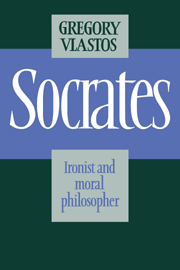Book contents
- Frontmatter
- Contents
- List of additional notes
- Introduction
- 1 Socratic irony
- 2 Socrates contra Socrates in Plato
- 3 The evidence of Aristotle and Xenophon
- 4 Elenchus and mathematics
- 5 Does Socrates cheat?
- 6 Socratic piety
- 7 Socrates' rejection of retaliation
- 8 Happiness and virtue in Socrates' moral theory
- Epilogue: Felix Socrates
- Additional notes
- Bibliography
- Index of passages cited
- Index of names in Plato and Xenophon
- Index of modern scholars
- Index of Greek words
4 - Elenchus and mathematics
Published online by Cambridge University Press: 21 October 2009
- Frontmatter
- Contents
- List of additional notes
- Introduction
- 1 Socratic irony
- 2 Socrates contra Socrates in Plato
- 3 The evidence of Aristotle and Xenophon
- 4 Elenchus and mathematics
- 5 Does Socrates cheat?
- 6 Socratic piety
- 7 Socrates' rejection of retaliation
- 8 Happiness and virtue in Socrates' moral theory
- Epilogue: Felix Socrates
- Additional notes
- Bibliography
- Index of passages cited
- Index of names in Plato and Xenophon
- Index of modern scholars
- Index of Greek words
Summary
At some time in the course of his life Plato acquired such thorough knowledge of mathematics that he was able to associate in the Academy on easy terms with the finest mathematicians of his time, sharing and abetting their enthusiasm for their work. The Academicorum Philosophorum Index Herculanensis (ed. Mekkler, p. 17) goes so far as to picture Plato as “masterminding” (ἀρχιτεκτον) the researches of his mathematical colleagues. This we may discount as eulogistic blow-up. Not so its further statement that Plato “set problems” to the mathematicians. Elsewhere I have argued for the credibility of the well-known report in Simplicius:
TI Simpl. in De Caelo 488.21–4: Plato had set this problem to those engaged in these studies: What uniform and ordered motions must be hypothesized to save the phenomenal motions of the wandering stars?
There is no good reason to doubt that Plato had been the first to project the idea that the apparently inconstant motions of the planets could be accounted for by compositions of invariantly constant circular motions proceeding in different planes, directions, and angular velocities. If Plato could hit on this powerful and fertile notion which “under the name of the Platonic axiom was to dominate theoretical astronomy for twenty centuries” and could propound it in a form which would strike Eudoxus and other practicing mathematical astronomers not as a pretty fancy but as a workable hypothesis, he must have been accepted by them as no dabbler in their business but as a student of their subject who understood it so well that his vision of progress in it might even be at certain points ahead of theirs.
- Type
- Chapter
- Information
- SocratesIronist and Moral Philosopher, pp. 107 - 131Publisher: Cambridge University PressPrint publication year: 1991
- 3
- Cited by



